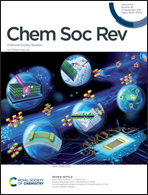Water compatible supramolecular polymers: recent progress
Abstract
Water compatible supramolecular polymers (WCSPs) combine aqueous compatibility with the reversibility and environmental responsiveness of supramolecular polymers. WCSPs have seen application across a number of fields, including stimuli-responsive materials, healable materials, and drug delivery, and are attracting increasing attention from the design, synthesis, and materials perspectives. In this review, we summarize the chemistry of WCSPs from 2016 to mid-2021. For the sake of discussion, we divide WCSPs into five categories based on the core supramolecular approaches at play, namely hydrogen-bonding arrays, electrostatic interactions, large π-conjugated subunits, host–guest interactions, and peptide-based systems, respectively. We discuss both synthesis and polymer structure, as well as the underlying design expectations. The goal of this overview is to deepen our understanding of the strategies that have been exploited to prepare WCSPs, as well as their properties and uses. Thus, a section devoted to potential applications is included in this review.



 Please wait while we load your content...
Please wait while we load your content...